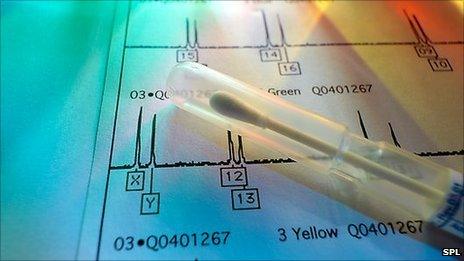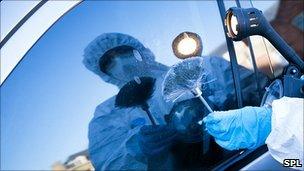DNA test jailed innocent man for murder
- Published

Scientists, lawyers and politicians have raised new concerns over the quality of forensic evidence testing - so is the criminal justice system too reliant on lab tests without realising their limitations?
"There was a knock at the door, in the early hours of the morning, saying I was being arrested for murder. I asked, 'what evidence have you got?' and they said they thought it was my DNA.
"I thought 'I'll prove I'm not a suspect' but it didn't pan out that way. DNA has become the magic bullet for the police... they thought it was my DNA, ergo it must be me."
David Butler has every right to be cynical about the use of DNA evidence by the police. He spent eight months in prison, on remand, facing murder charges after his DNA was allegedly found on the victim.
"That was when Alice fell down the hole. Everything went upside down. My whole life changed overnight," he told Radio 4's The Report.
"It was hard. The loneliness was the worst, not speaking to your family. I've led a good life, I've been a good man, and this to me was an absolute horror story."
The police had accused Mr Butler of murdering a woman, Anne Marie Foy, in 2005 - his DNA sample was on record after he had willingly given it to them as part of an investigation into a burglary at his mother's home some years earlier.
The DNA sample was only a partial match, of poor quality, and experts at the time said they could neither say that he was guilty nor rule him out.
Nevertheless he remained in prison - despite other CCTV evidence allegedly placing Mr Butler in the area where the murder took place being disproved.
Merseyside Police told the BBC that all the evidence gathered satisfied the Crown Prosecution Service that there was a sufficient case to be presented to a jury, but Mr Butler's solicitor Paolo Martini remains critical.
"I think in the current climate [DNA] has made police lazy," he said.
"It doesn't matter how many times someone like me writes to them, imploring they look at the evidence... they put every hope they had in the DNA result."
Missing the big picture
Mr Martini sought the help of a forensic expert to fight the case and it was apparent to them how a trace of Mr Butler's DNA came to be on the murder victim.

Testing of forensic evidence is now split between private labs and police labs
Mr Butler has a rare skin condition, which means he sheds flakes of skin, leaving behind much larger traces of DNA than the average person.
He worked as a taxi driver, and so it was possible for his DNA to be transferred from his taxi via money or another person, onto the murder victim.
The victim was also wearing a glitter nail polish, which proved particularly attractive to dirt - and DNA.
The case eventually went to trial and Mr Butler was acquitted and finally released after spending eight months on remand. Ms Foy's killer has never been caught and the case remains open.
Some commentators have questioned whether there are larger issues with the forensic landscape in the UK.
"The problem is the police now take a greater role in the decision about what tests to make," says Dr Sue Pope - the forensics expert employed to help Mr Butler.
"The problem with that is it commodifies everything into individual tests, rather than someone taking an overview on the whole case.
"I don't think it was until I came along and looked at it all that anyone had been in a position to see all the issues," she explains.
The "commodification" Dr Pope speaks of is in part due to the privatisation of forensic work in the UK, which has been a steady process over the last two decades.
This trend accelerated when the government closed the Forensic Science Service (FSS) in March this year, leaving behind a largely private market.
Criminal forensics is now broken down into different tasks as part of a national police framework - such as drugs tests, DNA crime scene stain tests, and other tests related to violent crime.
Private companies then bid for each bit of work - which is the root of the problem, say some critics.
"If you're provided with a menu, whereby you have to select a particular option, then that drives your decision making process into a little box too," says Jo Millington, a forensic scientist for 17 years, working for both the Forensic Science Service and the Metropolitan Police.
"You have people making these decisions with no forensic training or awareness [and] in some cases the wrong test is being asked for. There isn't an awareness of what is the best test to apply in any one circumstance," she adds.
Wrong questions?
The limitations of this fragmented approach is also recognised by some of the big firms undertaking much of the forensic test work on behalf of the police.
"The most common situation is when a murder weapon, a knife, has been used to stab somebody," explains Paul Hackett, managing director of Key Forensics.
"The knife is swabbed and the question asked of us is 'is there blood on the swab and can you send it for DNA profiling?' and then later on in court, the question is 'was that the murder weapon?'
"As forensic scientists we could potentially answer that question - if we had examined the knife," Mr Hackett says, "but clearly all the evidence is not available on the end of that swab."
The FSS was not immune to mistakes either and made some critical, high-profile blunders over the years - such as in the investigations into the murders of Damilola Taylor and Stephen Lawrence.
But given the concerns expressed by scientists and lawyers over the current fragmentation of evidence testing, are the police similarly worried about the current situation?
"If someone is suggesting that in the past a scientist examined every exhibit found at a scene, that has never been the case," says Chief Constable Chris Sims, the Acpo lead on forensic science.
"All forensic evidence is really saying is that a person left that sample and there has to be a broader circumstances to interpret what that means," says Mr Sims.
Lacking accreditation
But piecing together this big picture has become even more complicated, say critics, because many police forces have taken some forensic testing in-house. So, the testing on a single investigation might now be split between police teams and private labs.
This has riled private labs as not only have they lost business - in an industry where it is already tough to turn a profit - but police labs currently do not require accreditation in the same way private labs do.
This means the control systems and the reliability of technology in police labs do not have to meet the same stringent standards as their private counterparts.
This lack of accreditation concerns the Conservative MP Stephen Metcalfe, who sits on the Science and Technology Select Committee:
"That has to be a worry. If not having evidence produced in an accredited lab is an avenue open to those in the defence realm then they may well use that," he told The Report.
"That's why it's important that all labs should work to the same quality standard."
The Home Office says it has faith in police standards, and police labs are still expected to meet the standards set by the Forensic Science Regulator.
Acpo says all police labs will be seeking accreditation in the future - and out of the 43 forces across England and Wales, five have already been recommended for accreditation with another 23 having submitted applications.
But where does this mixed market leave the provision of forensic science in England and Wales?
"The science has been diminished certainly, not on a particular side, but for the criminal justice system as a whole," says Jo Millington, formerly of the FSS and the Met Police.
"I don't think it's presenting cohesive evidence that really does the best at each stage of the case."
And most importantly, what does it mean for the victim?
"Well, I think in any case that has to be your paramount priority, and if you're not doing your best at each stage of the investigation then ultimately they're losing out."
- Published28 August 2012
- Published18 July 2012
- Published31 October 2011
- Published11 March 2011
- Published2 March 2011